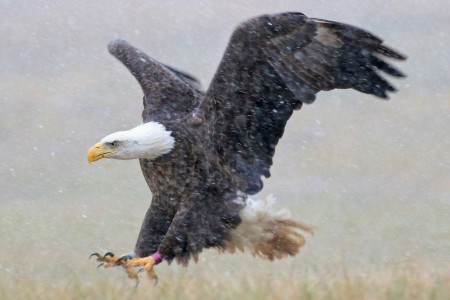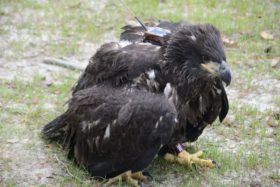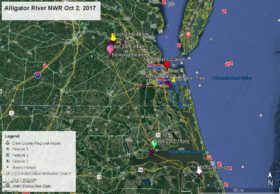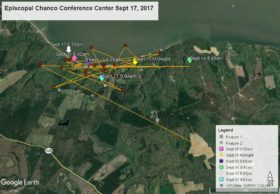



Tracked eagles continue to blaze trail for conservation
By Bryan Watts
Like a good investment, the cohort of CCB eagles fitted with satellite
transmitters between 2007 and 2009 continue to generate impressive dividends.
The cohort has now generated well over 1,000,000 GPS locations that are being
used to improve management techniques for the species.
In November, CCB was awarded a grant from the American Eagle Foundation to
establish a National Bald Eagle Roost Registry. Although communal roosts are
protected by federal law regulations have only rarely been implemented due to
the lack of information on their location. Among other sources, the tracking
data set will be used to delineate a large number of communal roosts to begin
populating the registry.
Also to begin in the new year, CCB will be working with federal and NGO partners
to delineate eagle movement corridors throughout the Northeast that will be used
in the siting of wind turbines. One of the most important considerations in
reducing the likelihood that a hazard will impact wildlife is location,
location, location. For birds, understanding how they move through the region
is critical to reducing mortality.
The cohort of eagles being tracked by CCB contains a number of individuals that
have made regular movements between the Chesapeake Bay and the north. One such
individual named Fairlee on the tracking website (http://www.seaturtle.org/) has
made multiple trips between a summering area on the St. Lawrence Seaway and
wintering area on the Chesapeake Bay. Collectively, these birds allow for the
delineation of major movement corridors that should be considered when planning
commercial wind farms.
Photo captions
Fairlee, an eagle being tracked by CCB as part of a movement study was
photographed during a snow on Aberdeen Proving Ground last Sunday (12/8/13).
Photo by Bart Roberts.
Fairlee as a nestling after being fitted with a satellite transmitter on
Aberdeen Proving Ground. Photo by Craig Koppie.
Fairlee with friend on Aberdeen Proving Ground. Photo by Bart Roberts.
Map of migrations made by Fairlee between winter grounds on the Chesapeake Bay
and summer grounds along the St. Lawrence Seaway.









3 Comments
This is wonderful new’s love the pix’s too.With all the wind turbines going up..something needs to be done to protect Eagle’s and other birds ..there has to be a better way..Thanks Reese
Congratulations on receiving the grant. What a success story it has been to put transmitters on Bald Eagles!
This is so exciting.It is like looking at our baby pics and I was wondering about the wind turbines,why cant they put some type of ditractant around the perimiters of the wind turbines that would deter the eagles.Like a motion detecter on large poles that would sound an alarm when a bird gets too close???I’m just thinking outside of the box here???